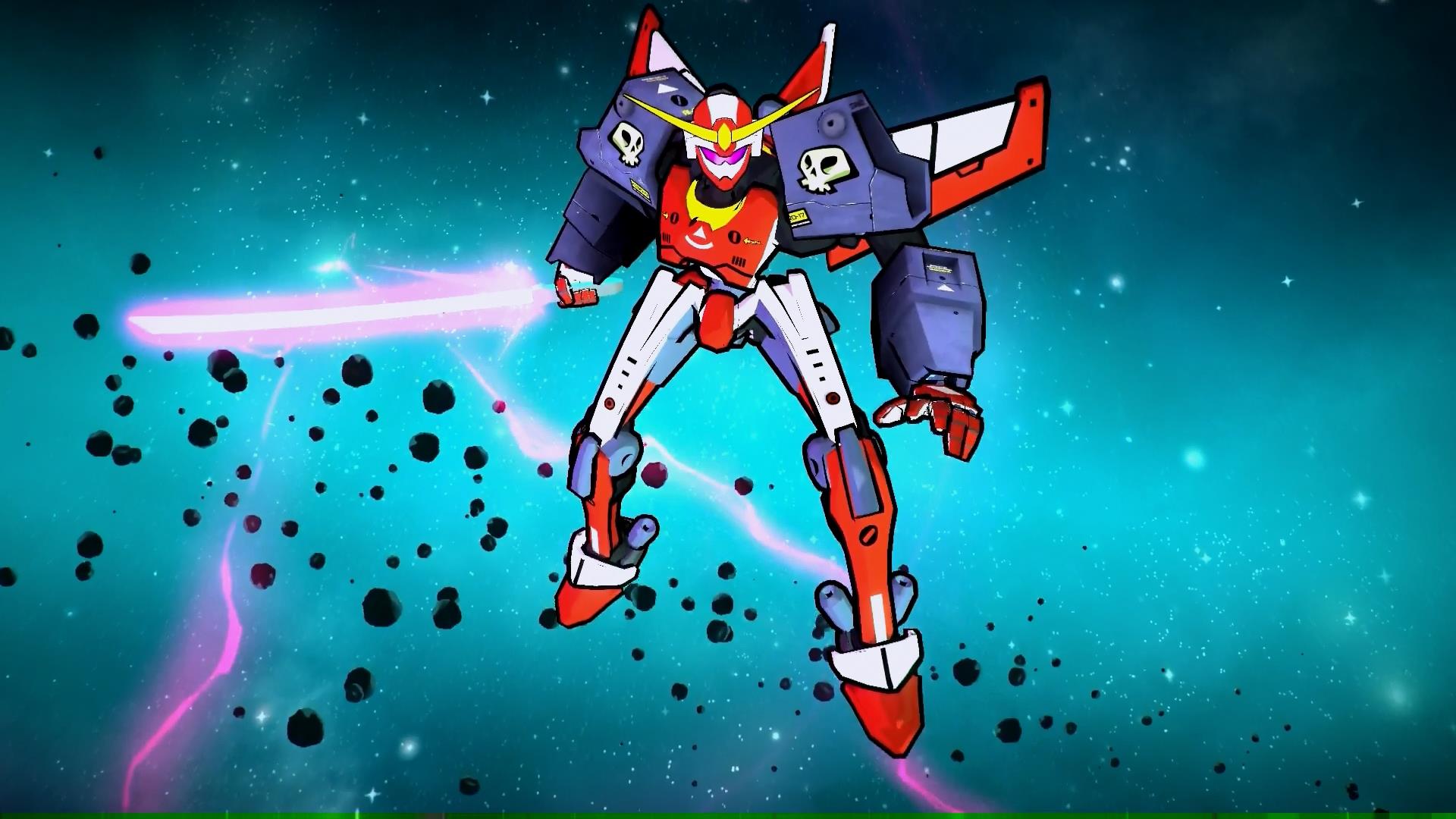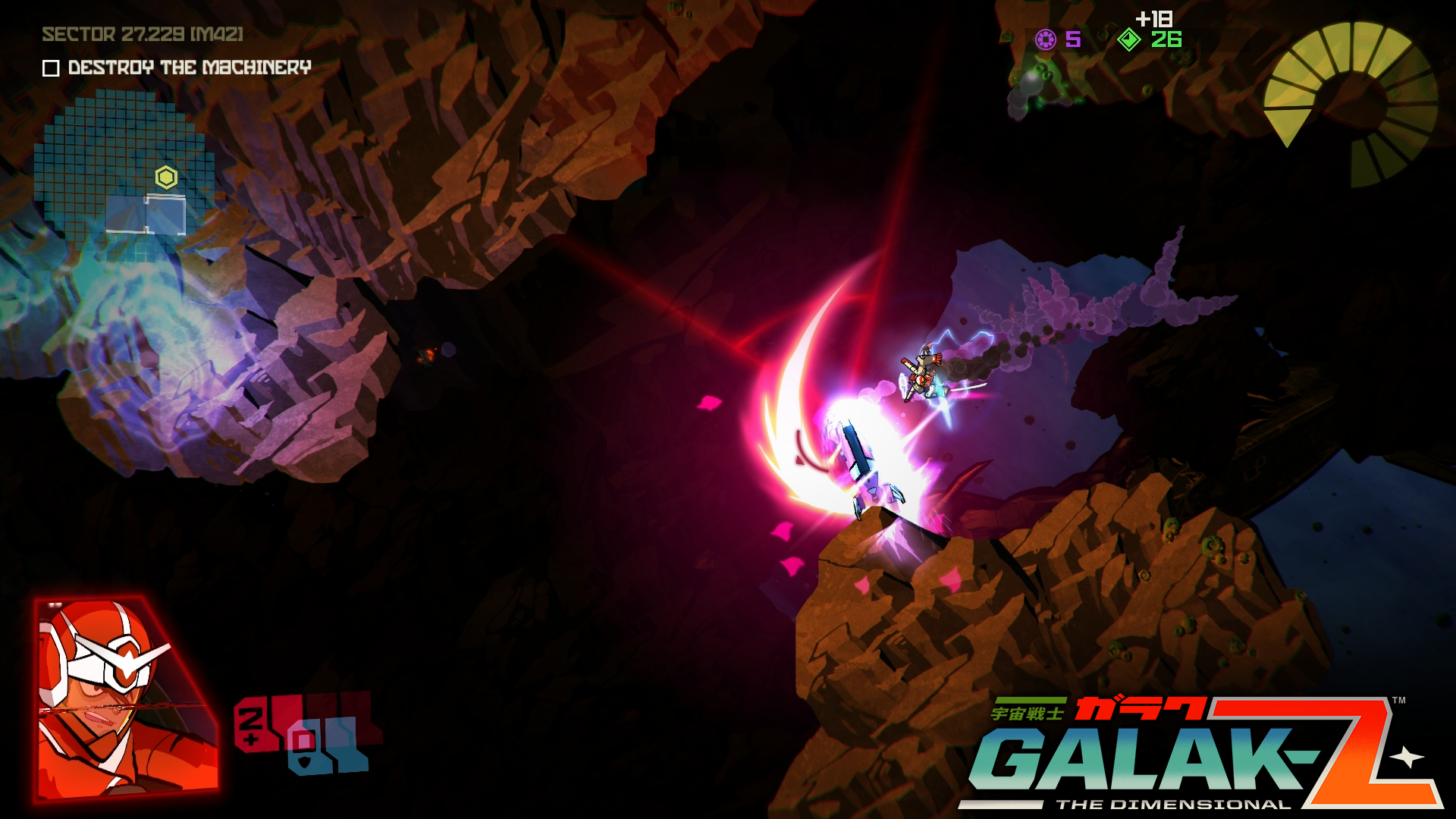Why Galak-Z's acrobatic space shootouts will be best on PC

Here are the three most important things I learned about Galak-Z this week, when lead designer Jake Kazdal stopped by the office to show off a near-final build of the game:
1. The PC version is coming relatively soon after Galak-Z’s August 4 launch on PlayStation 4. “We’ll be doing a lot more optimizations and difficulty tweaks, and a lot of the little stuff we’d like to keep noodling on for a bit” after the PS4 launch, said Kazdal. He hopes to have it out by the end of September. More on the PC version below.
2. Galak-Z is still just as hard and just as fun as it was when I played a much earlier in-progress build at 17-Bit’s Kyoto office back in September 2014. In fact, it’s even more fun now, with VO lines filled in, power-ups more prevalent on the map, and other quirks and missing elements in place. As for the difficulty, it’s got that roguelike bite: as soon as I got careless in combat, a couple shots would take down my shields and enemies would chew through my meager armor with glee.
The near-final PS4 build I played with Kazdal still had a few bugs in it—at one point the game began to stutter heavily, and Kazdal nitpicked small issues he wanted to fix before the game releases in two weeks—but I think the extra time between now and the PC launch will smooth out those last wrinkles.
3. There’s a mech. Of course there’s a mech. Somehow I didn’t assume from the start that Galak-Z’s space fighter was actually a transforming mecha in the classic anime tradition. The game screams Macross. But transform it does, and somehow Kazdal managed to keep that feature secret until now.
Transforming turns the long-range fighter into a mobile suit more adept at close-quarters combat thanks to a powerful energy sword and a ranged grab. Holding down the sword’s attack button charges it up for a more vicious swipe of lethal neon, and the swing has a great-feeling forward dash to it that can close the gap between you and a squirrely enemy ship. The grab has even more utility: enemies can’t fire on you while you’re holding them in a vise grip, and you can either pummel them or toss them into walls or other enemies, where physics damage comes into play. Finally, the mech has a directional shield, which can absorb a few heavy hits from enemies and is a lifesaver when your basic shields pop.

Switching between forms only takes a second or so—fast enough to transform in the middle of combat to block something with the mech’s shield or unleash a volley of the ship’s missiles. The sword’s powerful lunge feels much stronger than the ship’s base weapon, but getting up close is dangerous; dodging is key in Galak-Z, and some enemies have powerful shotgun blasts or missiles that can take out shields and a good chunk of your armor in one hit. The mech also doesn’t get weapon power-ups, making it more powerful early in a season and less powerful as you progress through a season’s five episodes.
The biggest gaming news, reviews and hardware deals
Keep up to date with the most important stories and the best deals, as picked by the PC Gamer team.
Galak-Z plays so much like an action game, it’s easy to forget that structurally, it’s a roguelike. The game is launching with four seasons, each comprised of five episodes. Those episodes are missions with randomly generated levels and objectives, like eradicating a den of bugs or hunting down valuable scrap. Finding new power-ups while on a mission unlocks them for that run, and means they’ll be added to the pool of random weapon options for sale in the shop. Die, and you lose the power-up, but you may be able to buy it your next go-round. It’s a needed bit of meta progression, because you’re going to die more than a few times while mastering Galak-Z’s space acrobatics.
Here’s a few clips of the mech in action, followed by Kazdal dishing on what he wants to add to the PC version of Galak-Z.
Galak-Z on PC
Galak-Z runs on Unity, which means the PC version shares most of its DNA with the PS4 version. “We built most of the game on PC and have been working on PS4, but the master build is PC,” Kazdal said. “Over the last couple of months as we’ve been finalizing and optimizing. We spent a lot of effort on PS4. I don’t think the PC build is as tight right now, but I would assume [it’ll be ready] by the end of September.”
That’s not a hard date, and I suspect it may slip back as the Galak-Z team codifies what features it wants in the PC version. “What I’d like to do, ideally, is have quality settings on the PC stuff,” Kazdal said. “We haven’t done that at all yet, because we’ve been so focused on shipping on PS4. That’ll take some time. But going all the way up to fully procedurally generated, every explosion, everything, all the way down to the canned simpler ones that are much less performance heavy. We can do settings: we can do, with these explosions, trigger X amount of particle effects, when it’s on low it’s only triggering 2 whereas up here it’s 10, something like that...I think, if you’ve got some stupid $4000 gaming PC and you’re a nut, you should be able to have the sickest-ass version of Galak-Z possible. I mean, why not?”
I went down a hit-list of features that I think PC players will really care about, and here’s what Kazdal had to say about each topic.
Mouse/keyboard controls?
“I think there is a control scheme with the keyboard only. I’ve got to come up with the mouse and keyboard configuration, being able to assign your own keys. I’m sure people are going to want that.”
What’s the controller support like?
Thanks to the PS4 version, Galak-Z obviously has PlayStation button icons. But if you plug in an Xbox controller on PC, it’ll auto-detect and give you the matching icons. Neato.
How about 4K support?
“We’ve got all our textures and stuff in Unity, most are archivable at 4096 [pixels wide], and then we clamp them to be, say, 1080 or 512 or whatever when they get pulled into the game. But in the project they're super high. But I assume we’d just dump them in at full size, and then you’d choose the quality settings. So we’ll have to set up rulesets. High means textures at 4096 but only if you have X amount of RAM. There’s a bunch of stuff that has to be taken into consideration.”
Framerate: 60 fps, or even beyond?
“Performance wise, I think the PC version is pretty much locked at 60. PS4 isn’t locked at 60. It plays at 60 a lot and doesn’t go below about 40 something, but the PC version’s definitely got a better framerate, even on a mid-range PC. And I haven’t seen it lately with these new optimizations, so I’m sure performance is better than ever on PC too.”
I asked if Galak-Z would be able to go beyond 60 to 120 Hz, and Kazdal said he didn’t know, so that one’s still to be determined.
Mod support?
Kazdal was interested in the potential for settings tinkering, though he didn’t have anything specific planned when it came to moddability. “I know of a couple settings that you could go in and fuck with. Maybe having a FAQ just for that, saying you can noodle with this, there’s no guarantees of performance, but if you want to go nuts, go nuts.”
Finally, we talked about features that would appeal to the roguelike community, like Spelunky’s Daily Challenge, which gives all players the same randomly generated level “seed” to play through and compete on score. He didn’t have any features to talk about for the PC launch, but he was just as excited about the idea as I was. He definitely had the idea in mind before I brought it up.
For more on Galak-Z, check out my feature Making Galak-Z: a day in the life of an indie studio in Kyoto, Japan.

Wes has been covering games and hardware for more than 10 years, first at tech sites like The Wirecutter and Tested before joining the PC Gamer team in 2014. Wes plays a little bit of everything, but he'll always jump at the chance to cover emulation and Japanese games.
When he's not obsessively optimizing and re-optimizing a tangle of conveyor belts in Satisfactory (it's really becoming a problem), he's probably playing a 20-year-old Final Fantasy or some opaque ASCII roguelike. With a focus on writing and editing features, he seeks out personal stories and in-depth histories from the corners of PC gaming and its niche communities. 50% pizza by volume (deep dish, to be specific).

